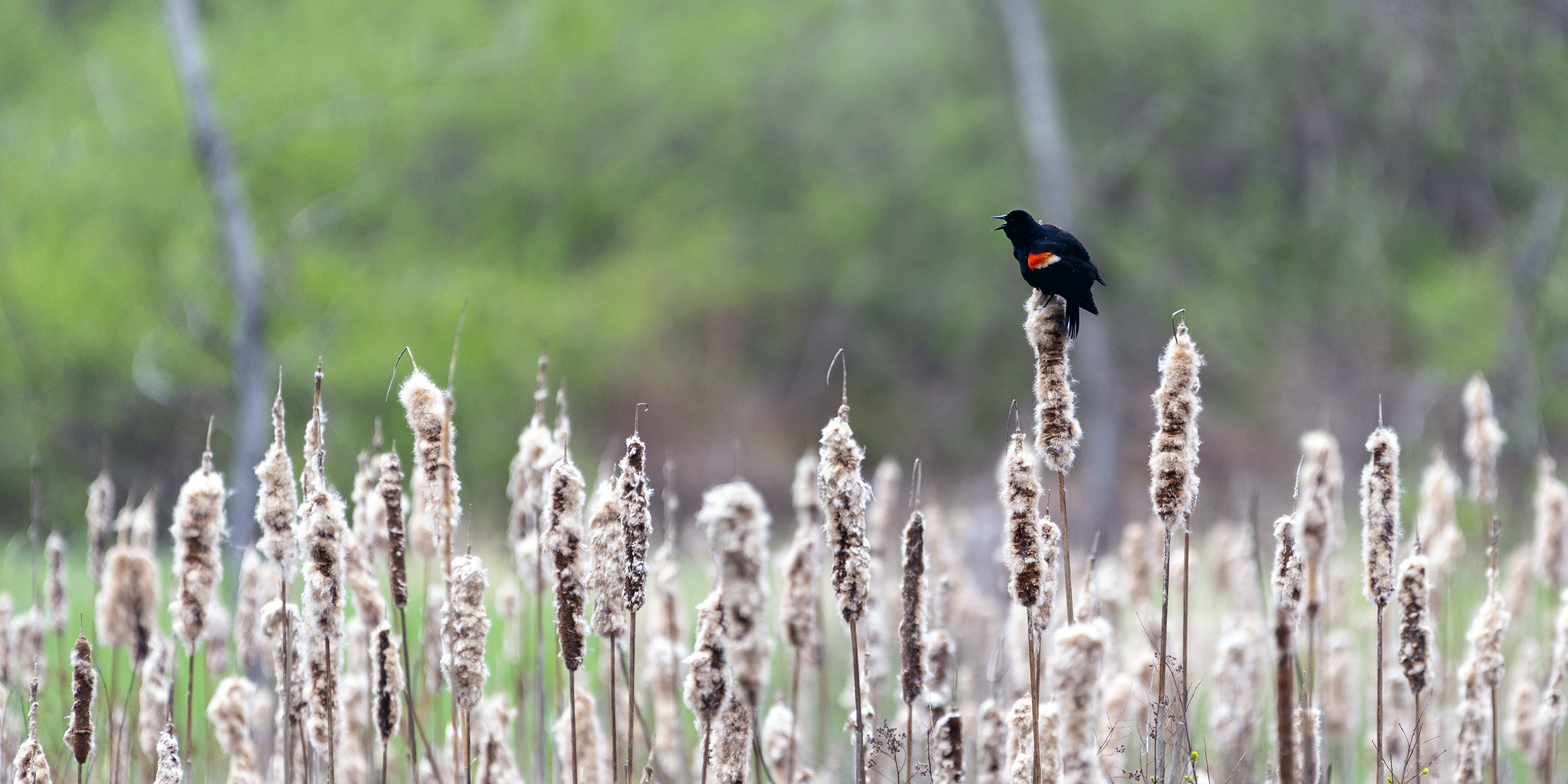Originally published 26 February 1996
One day this week we’ll hear the red-winged blackbird.
Down along the brook, in trees in the water meadow, the male birds will have taken up residence. We’ll hear them before we see them, off there beyond the tip-tip of the nuthatch and the ice-pick tunk of the downy woodpecker, their voices a raucous intrusion upon the snowy repose of the winter woods.
Before the peepers, before the skunk cabbage, before the ice has melted in the shady margins of the brook, we’ll hear the red-winged blackbird.
It’s not a pretty sound, the redwing’s song. A bit of a frog in its throat. Like water forcing its way through a frozen pipe.
A harbinger of spring should command a more sprightly song, more melodic, more forward looking.
But these things are subjective. Mabel Osgood Wright, who wrote about birds at the turn of the century, thought the redwing’s song is suggestive of “cool, moist ground and hidden springs.” William Hamilton Gibson, another early writer, heard a felicitous “gurgle and wet ooze.” These descriptions strike me as more hopeful than accurate.
Listening to the Redwing, Thoreau heard conk-a-ree. According to Emerson, “The Redwing flutes his ‘O ka lee.” Turn-of-the-century ornithologist Frank Chapman has it kong-quer-ree, and Gibson heard gl-oogl-eee. Other writers transcribe the song as gug-lug-geee, ookalee, onk-la-ree, and konk-la-reeee.
The only thing these writers agree on is the final, drawn-out eeeeee.
Unmistakable, yes, but getting the red-winged blackbird’s song reliably into a field guide has never been easy.
F. Schuyler Matthews, in 1904, set out to do a better job. In his Field Book of Wild Birds and their Music he tried to transcribe bird songs with musical notation. He gives the Redwing’s song as E, A, and trilled Cs in the key of A minor.
However, Matthews adds: “To be sure, the fellow is pardonably flat at times, and then again distressingly sharp; but on the whole the music is intelligible, welcome and even inspiring, for it’s a joyous announcement that spring is at hand.”
Matthews’ book of musical notations has undeniable charm, but it proved of little use in advancing the science of ornithology. Music, like syllables on paper, can be frustratingly subjective, and science strives for objectivity.
Field recording of bird songs has been possible since early in the century, but it was not until the 1950s that ornithologists acquired a way to reliably transcribe, exchange and compare bird sounds. Briton William H. Thorpe adapted for bird-song analysis a device invented at Bell Telephone Laboratories called a sound spectrograph, or sonograph.
The sonograph breaks a bird song down into its constituent frequencies and displays them as a graph of pitch versus time, called a sonogram. This breakthrough revolutionized the study of bird vocalization, and turned a subjective semi-science into a respectable branch of biology.
Anyone who doubts that much can be learned from sonograms should look at Thorpe’s classic Bird Song (1961), or Clive Catchpole’s and Peter Slater’s Bird Song (1995), both published by Cambridge University Press. The subtlety and richness of bird vocalizations prove the old adage that there are two musical races in the world — birds and humans.
Sonograms may be terrifically useful to the professional ornithologist, but they are not of much help to the amateur birdwatcher. The redwing’s song as displayed in Catchpole’s and Slater’s book looks something like a woolly bear caterpillar marching across graph paper while shedding its coat. In the Golden Field Guide to the Birds of North America—the only popular guide that provides sonograms — the redwing’s caterpillar is reduced to a smudge, between 2 and 5 kilocycles per second and about half a second long. Objective, yes. Romantic, no.
We are faced here with science’s perennial public relations problem. In this respect, science is rather like Bob Dole: It has the ability to get things done, but it is not particularly user- friendly in the field. The response of many people to something as coldly impersonal as a sonogram is to turn off science and stick with conk-a-ree. Settle for the subjective, the anthropomorphic.
Big mistake.
William H. Thorpe, who applied the sonograph to bird song, went on to write a classic book about learning and instinct in animals. His studies of animal behavior eventually led him to consider the evolutionary basis of human moral behavior.
Birds are worth knowing in their own right — their habits, their passages, their learnings, their communications. Without science, we listen to the redwing and hear only what we want to hear, an announcement of spring with a “gurgle and wet ooze,” a mirror of our own hopes.
With the knowledge provided by science, we are also allowed to participate in a world larger and richer than ourselves, a world in which all of creation awakens with the redwing’s call to a new season.



